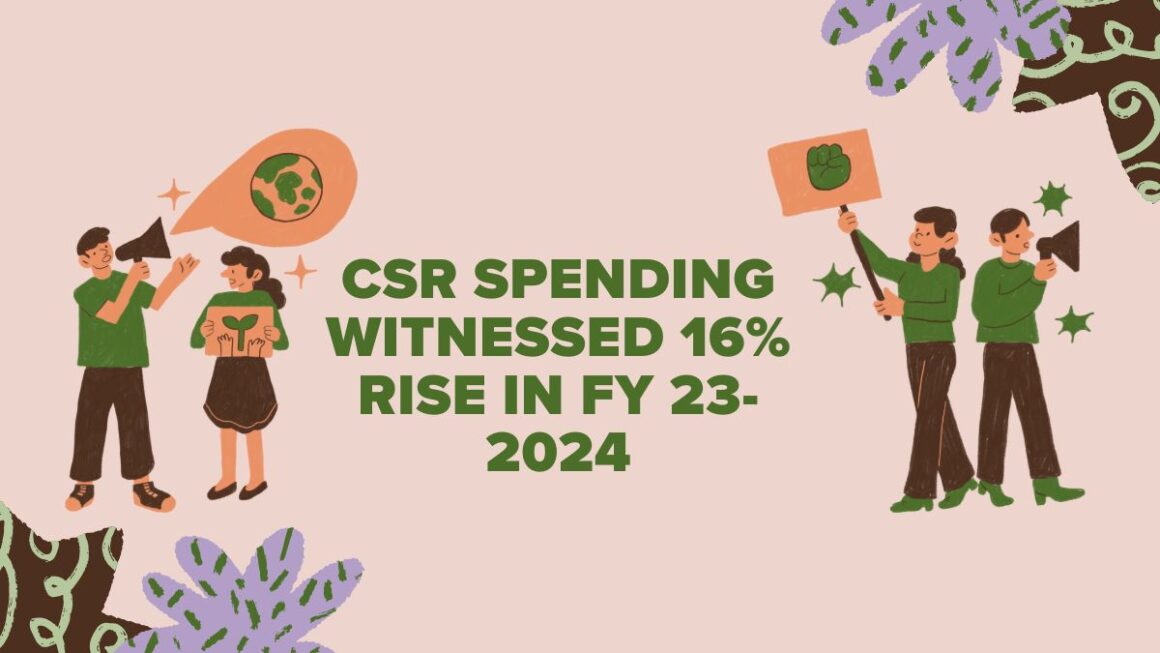
Corporate India’s social conscience is getting bigger and bolder. In FY 2023–24, companies spent a record-breaking ₹34,909 crore on Corporate Social Responsibility (CSR) with NSE-listed firms alone contributing nearly ₹18,000 crore, a 16% jump from the previous year. But as financial and energy-sector giants dominate the top spenders’ list, concerns around regional disparities and sector concentration persist. Here’s a deep-dive into who’s giving, what’s growing, and what still needs urgent attention.
Top 10 CSR Spenders in India (FY 2023–24)
| Rank | Company | CSR Spend (₹ Cr) | Key Highlights |
|---|---|---|---|
| 1 | HDFC Bank | ₹945.3 | Rural & tribal empowerment, digital finance, education |
| 2 | Reliance Industries | ₹900.0 | Healthcare infra, disaster relief, rural development |
| 3 | TCS | ₹827.0 | Digital literacy, STEM for girls, clean tech innovation |
| 4 | ONGC | ₹634.6 | Energy, health & environment via PSU programs |
| 5 | Tata Steel | ₹580.0 | Tribal upliftment, education, livelihood initiatives |
| 6 | ICICI Bank | ₹518.9 | Women empowerment, financial literacy, health |
| 7 | Indian Oil Corp (IOC) | ₹457.7 | Swachh Bharat, health clinics, clean energy |
| 8 | Infosys | ₹455.7 | Tech education, green villages, arts and culture |
| 9 | ITC Ltd. | ₹404.1 | Women-led rural entrepreneurship, afforestation |
| 10 | Power Grid Corp | ₹330.5 | Infrastructure-led rural education, access to energy |
These 10 companies alone accounted for 34% of the total CSR spend by listed companies—showing how India’s largest corporate houses are leading the charge.
India’s Growing CSR Footprint
CSR in India has come a long way from a compliance requirement to a strategic mandate. FY 2023–24 saw:
- ₹34,909 crore total CSR spend by 27,188 companies (listed + unlisted)
- ₹17,967 crore spent by NSE-listed companies, up 16% YoY
- ₹3,717 crore invested by 66 Public Sector Units (PSUs), up 19% YoY
Most-Active Sectors:
- Financial services (HDFC Bank, ICICI)
- Oil & energy (ONGC, IOC, Power Grid)
- Technology & services (TCS, Infosys)
“CSR is becoming a boardroom priority. It’s not just about checklists—it’s about legacy, leadership, and long-term market impact.”
— CSR strategist, Mumbai
Where the Money Is Going: Sector & State Highlights
Sector Focus:
| Category | Share of Total CSR (%) |
|---|---|
| Education | 34% |
| Healthcare | 27% |
| Rural Development | 12% |
| Environment | 10% |
| Women Empowerment | 5% |
Clearly, education and healthcare dominate, with increasing attention to climate and inclusion-focused programs.
State-Wise CSR Distribution (FY 2023–24)
| State | CSR Spend (₹ Cr) | YoY Growth |
|---|---|---|
| Maharashtra | ₹6,065.9 | High base |
| Gujarat | ₹2,707.5 | +31% |
| Karnataka | ₹2,254.9 | Stable |
While these three states lead CSR inflows, they also house the headquarters and major operations of top firms—explaining their prominence.
The Equity Problem: Who’s Being Left Behind?
Despite the growth, geographic disparities remain stark:
- Over 70% of CSR funds went to just 8 industrial states
- Northeast, Jharkhand, Bihar, Chhattisgarh and many aspirational districts received less than 4% combined
- Prime Database warns of a “widening CSR access gap” in rural and tribal India
“The Northeast needs CSR support in education, tech access, and disaster resilience—but most funds go where big companies are already present.”
— NGO head from Assam
What Makes Strategic CSR Tick?
Top-performing CSR programs in FY 2023–24 shared these traits:
✅ Integrated with business mission (TCS & digital education)
✅ Strong execution partnerships with local NGOs
✅ Sustained, long-term project focus
✅ Outcome tracking via tech dashboards or field audits
✅ Employee volunteering embedded into CSR culture
“It’s not about how much you spend—it’s about how deep you go. One well-executed school program can outperform a dozen photo-op initiatives.”
— CSR consultant, Bengaluru
Key Takeaways & Outlook
| Trend | Insight |
|---|---|
| CSR spending is rising | Driven by financial sector & PSU growth |
| Top 10 firms are driving strategy | 34% of listed company CSR came from just 10 leaders |
| Equity still lacking | Remote states receive a fraction of high-need funds |
| Strategic CSR is gaining ground | Long-term, community-anchored projects see more funding |
| Sectoral focus stabilizing | Education, healthcare still dominate; climate gaining ground |
Final Word: CSR Must Be Equity-Driven, Not Geography-Driven
India’s CSR map is expanding—but not evenly. With biggest firms showing strategic intent, there’s a real opportunity to reshape India’s socio-economic landscape. But that transformation won’t be complete unless underserved regions get a fair share.
If India’s corporate giants can combine their capital with compassion and decentralization, CSR won’t just be a policy—it’ll become a movement of sustainable impact.
Frequently Asked Questions (FAQs)
Q1: Is CSR mandatory in India?
Yes. Under Section 135 of the Companies Act, 2013, companies meeting certain financial thresholds must spend 2% of their average net profit over the last three years on CSR.
Q2: Which sectors receive most CSR funds?
Education (34%) and healthcare (27%) top the list, followed by rural development and environment.
Q3: Which states get the most CSR funds?
Maharashtra, Gujarat, and Karnataka—largely due to corporate presence.
Q4: Are PSUs contributing enough?
Yes. In FY 2023–24, 66 PSUs spent ₹3,717 crore, a 19% rise YoY.
Q5: Why is there concern about regional imbalance?
Industrial states dominate funding, while tribal and backward regions get minimal support—despite high development needs.
FOR MORE BLOGS – beyondthepunchlines.com

 Add to favorites
Add to favorites








